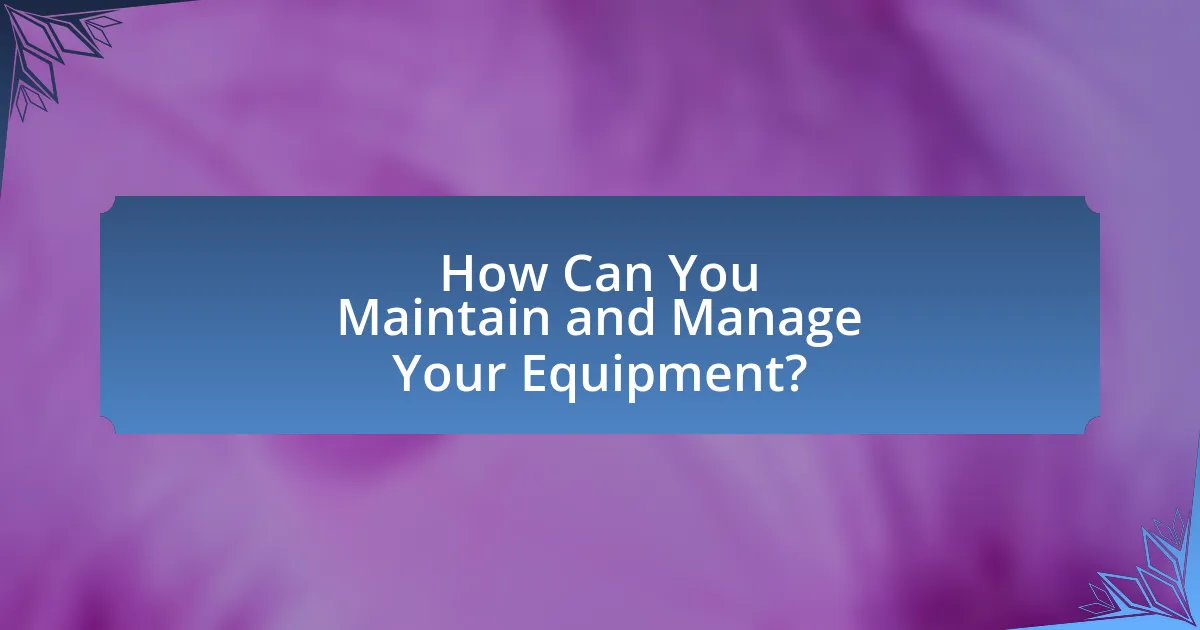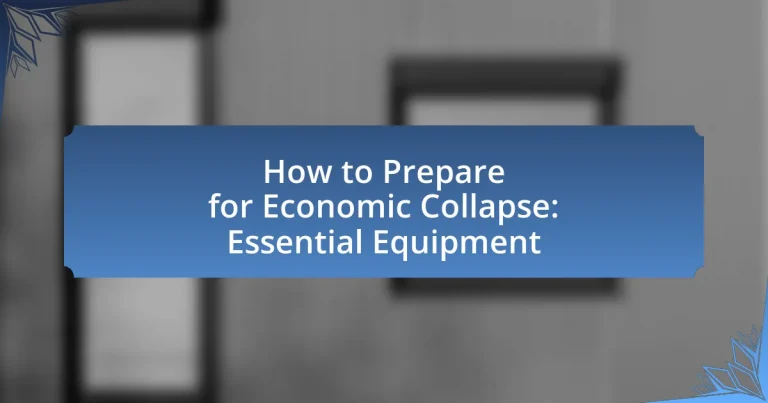Economic collapse refers to a significant decline in economic activity, leading to widespread unemployment, loss of consumer confidence, and failures of financial institutions. This article outlines the importance of preparing for such an event, highlighting historical examples like the Great Depression and the 2008 financial crisis. It discusses the signs of impending economic collapse, the potential impacts on daily life, and the necessity of having a comprehensive preparation plan. Essential equipment for survival, including food storage, water purification, medical supplies, and self-defense tools, is emphasized, along with strategies for maintaining and managing these resources effectively. The article also addresses common mistakes to avoid in preparation and the importance of community support during crises.

What is Economic Collapse and Why Should You Prepare?
Economic collapse is a severe decline in economic activity characterized by widespread unemployment, a significant drop in consumer confidence, and a failure of financial institutions. Preparing for economic collapse is crucial because it can lead to shortages of essential goods, increased crime rates, and a breakdown of social order, as evidenced by historical events like the Great Depression, where unemployment soared to 25% and many banks failed. By preparing, individuals can ensure access to necessary resources, maintain stability, and protect their families during uncertain times.
How can understanding economic collapse help in preparation?
Understanding economic collapse helps in preparation by enabling individuals and communities to anticipate potential disruptions and take proactive measures. By studying historical instances of economic collapse, such as the Great Depression, individuals can identify patterns and warning signs, allowing them to develop strategies for financial resilience. For example, during the Great Depression, many people faced unemployment and food shortages, which highlights the importance of having a diversified food supply and savings. This knowledge encourages the stockpiling of essential resources, creating emergency plans, and fostering community networks to support one another during crises.
What are the signs of an impending economic collapse?
Signs of an impending economic collapse include rising unemployment rates, significant drops in consumer spending, and increasing levels of national debt. For instance, during the 2008 financial crisis, the U.S. unemployment rate peaked at 10%, while consumer spending fell sharply, indicating a loss of confidence in the economy. Additionally, when national debt reaches unsustainable levels, as seen in Greece during its debt crisis, it can signal potential economic instability. Other indicators include stock market volatility, inflation rates exceeding wage growth, and a decline in manufacturing output, all of which can foreshadow a broader economic downturn.
Why is it important to have a plan in place?
Having a plan in place is crucial for effectively navigating potential economic collapse. A well-structured plan enables individuals and communities to anticipate challenges, allocate resources efficiently, and respond swiftly to emergencies. Research indicates that preparedness can significantly reduce the impact of crises; for instance, the Federal Emergency Management Agency (FEMA) states that having a disaster plan can improve recovery outcomes by up to 50%. This evidence underscores the importance of proactive planning in mitigating risks associated with economic instability.
What are the potential impacts of an economic collapse?
An economic collapse can lead to widespread unemployment, loss of savings, and increased poverty levels. During the Great Depression of the 1930s, unemployment rates soared to about 25% in the United States, illustrating the severe impact on job availability and financial stability. Additionally, an economic collapse often results in a breakdown of essential services, as government revenues decline and public spending is cut. Historical instances, such as the 2008 financial crisis, show that many individuals faced foreclosures and bankruptcies, further exacerbating social unrest and crime rates. Food and resource shortages can also occur, as supply chains become disrupted, leading to inflation and increased prices for basic necessities.
How does economic collapse affect daily life?
Economic collapse significantly disrupts daily life by leading to widespread unemployment, scarcity of essential goods, and increased crime rates. During economic downturns, job losses can reach as high as 25%, as seen in the Great Depression, which drastically reduces household incomes and purchasing power. This financial strain results in limited access to food, healthcare, and basic services, as supply chains falter and inflation rises. Additionally, social unrest often escalates, with crime rates increasing due to desperation, as evidenced by spikes in theft and violence during past economic crises. These factors collectively create an environment of uncertainty and hardship, fundamentally altering the way individuals and families navigate their daily routines.
What are the risks associated with not preparing?
The risks associated with not preparing for an economic collapse include financial instability, lack of essential resources, and increased vulnerability to social unrest. Financial instability can lead to loss of savings and assets, as seen during the 2008 financial crisis when millions faced foreclosure and unemployment due to inadequate preparation. Lack of essential resources, such as food, water, and medical supplies, can result in severe hardship during crises, as evidenced by the panic buying and shortages experienced during the COVID-19 pandemic. Increased vulnerability to social unrest can manifest in heightened crime rates and civil disorder, as communities struggle to cope with scarcity and desperation, which was observed in various regions during economic downturns.

What Essential Equipment Should You Consider for Preparation?
Essential equipment for preparation in the context of an economic collapse includes non-perishable food, water filtration systems, first aid kits, and self-defense tools. Non-perishable food, such as canned goods and freeze-dried meals, ensures sustenance during prolonged shortages. Water filtration systems, like portable filters or purification tablets, provide safe drinking water, which is critical for survival. First aid kits are essential for addressing medical emergencies, containing supplies like bandages, antiseptics, and medications. Self-defense tools, such as pepper spray or personal alarms, enhance personal safety in uncertain environments. These items are vital for maintaining health, safety, and sustenance during crises, as evidenced by survivalist literature and preparedness guidelines from organizations like the Federal Emergency Management Agency (FEMA).
How do you determine what equipment is essential?
To determine what equipment is essential for preparing for economic collapse, one must assess the specific needs based on survival priorities such as food, water, shelter, and security. Essential equipment typically includes items that ensure basic survival, such as water filtration systems, non-perishable food supplies, first aid kits, and tools for self-defense. Research indicates that during crises, access to clean water and food is critical, as highlighted in the FEMA guidelines, which emphasize the importance of having at least a three-day supply of food and water for emergencies. Therefore, evaluating personal circumstances, local resources, and potential threats will guide the selection of essential equipment effectively.
What categories of equipment should you focus on?
You should focus on categories of equipment that include food storage, water purification, medical supplies, self-defense tools, and energy sources. These categories are essential for survival during an economic collapse, as they address basic human needs such as sustenance, safety, and health. For instance, food storage solutions like freeze-dried meals can last for years, while water purification systems ensure access to clean drinking water, which is critical in emergencies. Medical supplies, including first aid kits and essential medications, are vital for treating injuries and illnesses. Self-defense tools, such as pepper spray or personal alarms, enhance personal safety in uncertain environments. Lastly, energy sources like solar chargers or generators provide power for essential devices when traditional power sources may fail.
How can you prioritize your equipment needs?
To prioritize your equipment needs, first assess the critical functions required for survival during an economic collapse, such as food, water, shelter, and security. Identify the equipment that directly supports these functions, ranking them based on urgency and necessity. For instance, water purification systems should take precedence over luxury items like recreational gear, as access to clean water is vital for survival. Research indicates that prioritizing essential survival gear can significantly increase resilience; a study by the National Center for Disaster Preparedness highlights that preparedness directly correlates with reduced vulnerability in crises. Therefore, focusing on the most essential equipment ensures that you are better equipped to handle emergencies effectively.
What types of food and water supplies are necessary?
Essential food supplies include non-perishable items such as canned goods, dried grains, legumes, and freeze-dried meals, while necessary water supplies should consist of clean, potable water stored in containers, ideally at least one gallon per person per day for a minimum of three days. Non-perishable foods provide long shelf lives and essential nutrients, ensuring sustenance during economic instability. Water is critical for hydration and food preparation, and the recommended storage amount aligns with emergency preparedness guidelines from organizations like the Federal Emergency Management Agency (FEMA).
How much food and water should you store?
You should store at least one gallon of water per person per day for a minimum of three days, totaling 12 gallons for a family of four. Additionally, it is recommended to have a supply of non-perishable food that lasts for at least three days, ideally aiming for a two-week supply. This recommendation is based on guidelines from the Federal Emergency Management Agency (FEMA), which emphasizes the importance of having sufficient water and food to sustain individuals during emergencies.
What are the best methods for food preservation?
The best methods for food preservation include canning, freezing, drying, and vacuum sealing. Canning involves sealing food in airtight containers and heating them to kill bacteria, which can extend shelf life for years. Freezing preserves food by slowing down enzyme activity and preventing spoilage, making it effective for various food types. Drying removes moisture from food, inhibiting the growth of microorganisms, and is a traditional method used for fruits, vegetables, and meats. Vacuum sealing removes air from packaging, which helps prevent oxidation and spoilage, and is often used in conjunction with freezing. These methods are widely recognized for their effectiveness in extending the longevity of food, ensuring safety, and maintaining nutritional value.
What tools and gear are critical for survival?
Critical tools and gear for survival include a multi-tool, water filtration system, first aid kit, fire-starting equipment, and durable shelter materials. A multi-tool provides various functions such as cutting, screwing, and opening, which are essential for numerous survival tasks. A water filtration system ensures access to clean drinking water, vital for survival, as contaminated water can lead to illness. A first aid kit is crucial for treating injuries and preventing infections, which can be life-threatening in survival situations. Fire-starting equipment, such as waterproof matches or a fire starter, is necessary for warmth, cooking, and signaling for help. Durable shelter materials, like tarps or emergency blankets, protect against the elements, which is critical for maintaining body temperature and safety. These items are widely recognized in survival literature and training programs as fundamental for effective survival strategies.
Which tools are essential for self-sufficiency?
Essential tools for self-sufficiency include a multi-tool, a hand saw, a shovel, a garden hoe, and a water filtration system. These tools enable individuals to perform a variety of tasks necessary for sustainable living, such as building, gardening, and water purification. For instance, a multi-tool combines several functions, allowing for efficient repairs and maintenance, while a hand saw is crucial for cutting wood for shelter or fuel. A shovel is essential for digging, whether for planting or creating drainage, and a garden hoe is vital for cultivating soil and growing food. Lastly, a water filtration system ensures access to clean drinking water, which is critical in any self-sufficient setup.
How can you choose the right gear for your environment?
To choose the right gear for your environment, assess the specific conditions and challenges you may face, such as climate, terrain, and potential threats. For instance, if you live in a cold climate, prioritize insulated clothing and gear designed for low temperatures, while in a humid environment, focus on breathable materials to prevent overheating. Additionally, consider the durability and functionality of the gear; items made from high-quality materials will withstand harsh conditions better. Research shows that individuals who select gear tailored to their environment are more prepared for emergencies, as evidenced by a study from the University of California, which found that appropriate gear significantly increases survival rates in adverse conditions.

How Can You Maintain and Manage Your Equipment?
To maintain and manage your equipment effectively, implement a regular maintenance schedule that includes cleaning, inspection, and necessary repairs. Regular cleaning prevents dirt and grime buildup, which can lead to equipment failure; for instance, a study by the National Institute of Standards and Technology indicates that routine maintenance can extend the lifespan of machinery by up to 30%. Additionally, conducting inspections allows for early detection of potential issues, reducing the risk of costly breakdowns. Keeping detailed records of maintenance activities and repairs ensures accountability and helps track the performance of each piece of equipment.
What are the best practices for equipment maintenance?
The best practices for equipment maintenance include regular inspections, timely repairs, and adherence to manufacturer guidelines. Regular inspections help identify potential issues before they escalate, ensuring equipment operates efficiently and safely. Timely repairs prevent minor problems from becoming major failures, which can lead to costly downtime. Adhering to manufacturer guidelines ensures that maintenance procedures are performed correctly, prolonging the lifespan of the equipment. According to a study by the U.S. Department of Energy, proper maintenance can increase equipment efficiency by up to 30%, highlighting the importance of these practices in maintaining operational effectiveness.
How often should you check and replace supplies?
You should check and replace supplies every six months to ensure they remain effective and usable. Regular inspections help identify expired items, assess the condition of supplies, and maintain readiness for emergencies. Research indicates that supplies, particularly food and medical items, can degrade over time, making biannual checks a practical guideline for maintaining optimal preparedness.
What storage solutions are effective for long-term preservation?
Effective storage solutions for long-term preservation include vacuum sealing, refrigeration, and using airtight containers. Vacuum sealing removes air, which helps prevent spoilage and extends shelf life, making it ideal for food preservation. Refrigeration slows down the growth of bacteria and mold, ensuring that perishable items remain safe for extended periods. Airtight containers protect against moisture and pests, which can compromise the integrity of stored items. These methods are supported by studies indicating that proper storage techniques can significantly enhance the longevity of various materials, including food and sensitive documents.
How can you adapt your equipment to changing circumstances?
To adapt your equipment to changing circumstances, regularly assess the environment and adjust your gear accordingly. For instance, if facing extreme weather, ensure your equipment is weather-resistant or includes protective covers. Additionally, modular equipment that allows for easy upgrades or modifications can be beneficial; for example, using interchangeable parts can enhance functionality based on specific needs. Historical data shows that individuals who equipped themselves with versatile tools, such as multi-tools or adaptable storage solutions, were better prepared during economic downturns, as they could repurpose their gear for various tasks.
What modifications can enhance your equipment’s effectiveness?
Modifications that can enhance your equipment’s effectiveness include upgrading components, optimizing maintenance routines, and incorporating technology. Upgrading components, such as using higher-quality materials or more efficient parts, can significantly improve performance and durability. For example, replacing a standard battery with a lithium-ion battery can increase energy efficiency and lifespan. Optimizing maintenance routines, such as regular cleaning and timely repairs, ensures that equipment operates at peak performance, reducing the risk of failure during critical times. Incorporating technology, like smart sensors or automation, can enhance functionality and provide real-time data for better decision-making. These modifications are supported by studies showing that regular maintenance and upgrades can extend equipment life by up to 50% and improve operational efficiency by 30%.
How do you stay informed about new survival gear?
I stay informed about new survival gear by regularly following reputable outdoor and survival gear websites, subscribing to industry newsletters, and participating in online forums dedicated to survivalism. These sources provide timely updates on product releases, reviews, and innovations in survival gear. For instance, websites like Outdoor Life and Survivalist Magazine often feature articles on the latest gear trends and expert recommendations, ensuring that I have access to reliable information. Additionally, engaging with communities on platforms like Reddit allows for real-time discussions and insights from fellow enthusiasts, further enhancing my knowledge of emerging survival equipment.
What are some practical tips for effective preparation?
Effective preparation for an economic collapse involves creating a comprehensive plan that includes gathering essential supplies, securing financial resources, and developing skills for self-sufficiency. First, individuals should prioritize acquiring non-perishable food, clean water, medical supplies, and essential tools, as these items will sustain them during crises. Research indicates that having a minimum of three months’ worth of food and water is advisable for emergency preparedness (FEMA guidelines).
Next, securing financial resources such as cash, precious metals, or barter items can provide stability when traditional banking systems may fail. Studies show that diversifying assets can mitigate risks during economic downturns. Additionally, developing practical skills like gardening, basic first aid, and home repair can enhance self-sufficiency and reduce reliance on external resources.
Finally, forming a community network can provide support and share resources, which is crucial during challenging times. According to the American Red Cross, community preparedness significantly increases resilience in emergencies.
How can you create a comprehensive preparation plan?
To create a comprehensive preparation plan for an economic collapse, begin by assessing potential risks and identifying essential resources needed for survival. This involves evaluating factors such as food, water, shelter, medical supplies, and security measures. Research indicates that individuals should aim for a minimum of three months’ worth of non-perishable food and water, as recommended by emergency management agencies. Additionally, creating a budget for purchasing necessary equipment and supplies, while also developing skills in areas like first aid and self-defense, enhances preparedness. Regularly reviewing and updating the plan ensures it remains relevant to changing circumstances and personal needs.
What common mistakes should you avoid when preparing?
Common mistakes to avoid when preparing for an economic collapse include underestimating the importance of a comprehensive plan, neglecting to stock essential supplies, and failing to stay informed about current events. A comprehensive plan ensures that individuals have a clear strategy for various scenarios, while neglecting essential supplies can lead to shortages during crises. Staying informed allows for timely adjustments to preparation strategies based on evolving situations. Research indicates that individuals who plan thoroughly and remain adaptable are better equipped to handle emergencies effectively.


